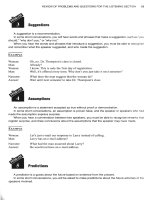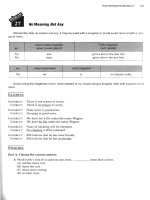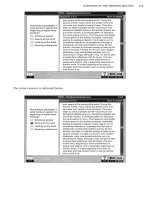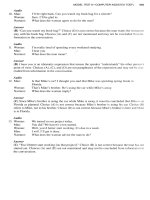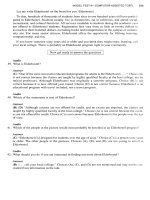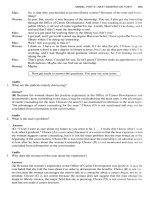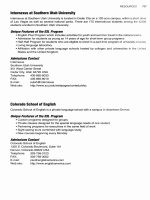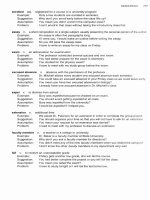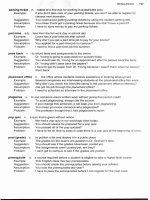Introduction to WebTrust for Certification Authorities – WebTrust for Extended Validation Audit Criteria doc
Bạn đang xem bản rút gọn của tài liệu. Xem và tải ngay bản đầy đủ của tài liệu tại đây (383.75 KB, 89 trang )
Introduction to WebTrust for Certification Authorities – WebTrust for Extended
Validation Audit Criteria
The attached WebTrust for Certification Authorities – WebTrust Extended Validation
Audit Criteria (DRAFT) has been prepared in cooperation with internet browsers and
issuers of digital certificates by the WebTrust for Certification Authorities Working
Group. The attached document is in draft form recognizing that there has not yet been
any Extended Validation Certificates issued or wide exposure of the guidelines.
However, a significant requirement for the acceptance of Extended Validation
Certificates by browsers is the completion of an examination by licensed WebTrust
practitioners. This document should be used as the basis for conducting such an
examination for the purposes of meeting industry expectations. This document has had
the benefit of being commented on by both browsers and many issuers of digital
certificates. Included in the attached document is both the WebTrust Criteria for
Extended Validation Certificates as well as the industry developed Criteria for Extended
Validation Certificates.
We would appreciate any comments you may have based on your experiences with using
WebTrust for Certification Authorities – WebTrust Extended Validation Audit Criteria
(DRAFT). Please address your comments to:
Bryan Walker, CA
New Assurance Services Group
Canadian Institute of Chartered Accountants
277 Wellington St West
Toronto, Ontario
Canada, M5V 3H2
Or by email
WEBTRUST FOR CERTIFICATION
AUTHORITIES – WEBTRUST EXTENDED
VALIDATION AUDIT CRITERIA
BASED ON:
CA/BROWSER FORUM
GUIDELINES FOR
EXTENDED VALIDATION CERTIFICATES
DRAFT October 20, 2006
Version 1.0 – Draft 11
iii
Copyright
©
2006 by
Canadian Institute of Chartered Accountants.
All rights reserved. The Principles and Criteria may be reproduced and distributed
provided that reproduced materials are not in any way directly offered for sale or
profit and attribution is given.
iv
Table of Contents
Page
Introduction iv
WebTrust EXTENDED VALIDATION Criteria 1
Appendix A – Illustrative Practitioner’s Reports 15
Appendix B – CA/Browser Forum Guidelines for
Extended Valuation Certificates
18
This document has been prepared for the use of licensed WebTrust practitioners,
Certification Authorities, Bowsers and users of Extended Validation Certificates by the
WebTrust Certification Authorities Advisory Group. Members of this Group are:
Chair
Donald E. Sheehy
Deloitte & Touche LLP
Michael Greene
Ernst & Young LLP
Mark Lundin
KPMG LLP
Jeffrey Ward
Stone Carlie & Company LLC
Staff Contact
:
Bryan Walker,
Canadian Institute of
Chartered Accountants
v
Introduction
1. “The explosive growth of internet transactions and web services relies on strong
authentication of the identity of web sites, domain owners and online servers.
Browser developers, other application developers, and many of the certification
authorities (CAs) that issue TLS/SSL certificates, all support improved and
standardized certificates to provide stronger assurance of organizational identity
than is often the case with certificates used on the web today (early 2006).”
1
2. The Certificate Authorities and browser developers have worked together to
develop guidelines that creates the basis for differentiating certificates which have
stronger authentication standards than other certificates. Certificates that have
been issued under stronger authentication controls, processes and procedures are
called Extended Validation (“EV Certificates”).
3. A working group consisting of many of the issuers of digital certificates and
browser developers has developed a set of guidelines that set out the expected
requirements for issuing EV certificates. This group is known as the CA Browser
Forum (“CAB Forum”). The guidelines are entitled “Guidelines for Extended
Validation Certificates” (“EV Guidelines”). A copy of these guidelines can be
found at
4. CAs and browser developers have recognized the importance of an independent
third party examination of the controls, processes and procedures of CAs.
Accordingly, the EV Guidelines include a specific requirement for CAs that wish
to issue EV certificates to undergo a WebTrust for Certification Authorities
examination or equivalent which would cover hierarchy roots and subordinate
roots involved in the EV Certificate process. There is also a requirement that the
CA would undergo an additional independent examination by the WebTrust
auditor to provide an opinion whether the additional requirements for the issuance
of EV certificates have also been followed.
5. The purpose of this EV Addendum to the WebTrust Program Certification
Authorities is to set additional criteria and examples of reports that would be used
by the WebTrust auditor with respect to providing the assurances requested by the
CA, browsers and other users. With one exception this Addendum should be
used only in conjunction with the Principles and Criteria contained in the
current version of the WebTrust Program for Certification Authorities.
These criteria may be used on a standalone basis for the purposes of issuing a
readiness report provided that the CA has a current WebTrust for
Certification Seal.
6. This Addendum contains additional criteria to be tested by the WebTrust auditor
when providing assurances with respect to EV certificates. It also provides some
1
Extracted from an unpublished background paper prepared for the CA Browser Forum called “The Quill
Guidelines”.
vi
additional guidance in the form of illustrative controls to assist the WebTrust
auditor in understanding the intent of the specific criteria and sample reports that
illustrate the form of reports that is expected from WebTrust auditors. .
Transition and Adoption
7. In order to meet the needs and expectations of the market place, these WebTrust
Guidelines for Extended Validation Certificates (The WT EV Guidelines)
included in this Addendum may be used effective [TBD]. The WT EV Guidelines
have been developed by an experienced Working Group of WebTrust for
Certification Authority practitioners. The WT EV Guidelines have been circulated
to CAB Forum participants as well as other experienced WebTrust for
Certification Authorities practitioners. These guidelines, however, should be
considered “draft” however until a broader constituency has used and become
familiar with them. Based on experience with these criteria subsequent changes
may be made before the Guidelines should be considered final. In addition, it is
expected that these criteria will be reviewed by the AICPA’s Assurance Service
Executive Committee.
8. As mentioned, the WT EV Guidelines are only to be used in conjunction with the
Principles and Criteria in the WebTrust Program for Certification Authorities.
CAs that wish to issue EV Certificates must first go through a WT examination
and then a WT for EV examination. The WebTrust auditor should identify the
CA’s requirements early in the process to identify whether the WebTrust report
will be used to support the issuance of EV certificates. {See section 35 A]
9. The two examinations would normally be conducted simultaneously. In the
interim however, it is expected that they will be conducted separately. For CAs
that have successfully (successfully meaning an opinion without reservation
issued by the WebTrust auditor) undergone a WebTrust for Certification (WT for
CA) examination and the report and related WebTrust seal are still current (see
WebTrust Program for Certification Authorities page xx), the procedures
undertaken by the WebTrust auditor would only be those that are necessary to
examine the added procedures for EV certificates. The currently valid WebTrust
for Certification Authorities examination would not need to be updated to a more
recent date that would match the date of the WT EV examination.
10. For CAs that do not have a currently valid WebTrust report, the criteria contained
in the WebTrust Program for Certificate Authorities and the criteria in this
Addendum would be tested.
Reports
Organizations with a currently valid WebTrust Report
11. It is acceptable for a WebTrust Auditor to issue a “point in time” report with
respect to providing assurance on WT for EV criteria. This is acceptable for the
initial examination only. At the time the existing WebTrust report is to be
vii
renewed, however, the examination should cover the full twelve months or less
following the period covered by the previous WebTrust report. (See Sample
Reports [to be developed]).
12. For examples of an initial report on a CAs readiness to meet the WebTrust for EV
Certificates criteria see Appendix A.
Organizations without a currently valid WebTrust Report
13. An important element for acceptance of EV certificates by the browser developers
is the existence of a non-qualified WebTrust opinion. In order to facilitate
acceptance by the browser developers, the WebTrust auditor may issue a “point in
time” report that covers the criteria in both the WebTrust Program for
Certification Authorities and the Addendum. (See Sample Reports [to be
developed]).
WebTrust Seal Issues
14. A WebTrust seal is provided to CAs that have successfully completed a WebTrust
examination that covers a period of time.
15. A WebTrust Seal is provided to any CA that meets the criteria established in the
WebTrust program for Certification Authorities. A CA does not need to meet the
additional criteria established in this Addendum to obtain a WebTrust for
Certification Authorities Seal.
16. The WebTrust working group is considering the question as to whether the
WebTrust seal should be modified to differentiate between EV certificates and
non-EV Certificates. Until a decision is made the current WebTrust Seal will be
used in both circumstances. The differentiation of the two levels of certificates
will be evidenced by the user interface established by the browser developers and
disclosures made by the CA with respect to the certificates that it has issued.
1
WEBTRUST FOR CERTIFICATION
AUTHORITIES – WEBTRUST EV AUDIT
CRITERIA
PRINCIPLE 1: CA EV Business Practices Disclosure - The Certification Authority discloses its EV
Certificate practices and procedures and its commitment to provide EV Certificates in conformity with
the CA/Browser Forum Guidelines.
WebTrust EV Criteria
1
The CA and its Root CA discloses
2
on its website its
• EV Certificate practices, policies and procedures.
• CAs in the hierarchy whose subject name is the same as the EV issuing CA, and
• its commitment to conform with CA/Browser Forum Guidelines for Extended Validation
Certificates
( See EV Certificate Guidelines Section 4 (b) (3) )
2 The Certificate Authority has published guidelines for revoking EV Certificates.
( See EV Certificate Guidelines Section 27 (a))
3 The CA provides instructions to Subscribers, Relying Parties, Application Software Vendors
and other third parties for reporting complaints or suspected private key compromise, EV
Certificate misuse, or other types of fraud, compromise, misuse, or inappropriate conduct
related to EV Certificates to the CA .
(See EV Certificate Guidelines Section 28)
4 The CA and its Root has controls to provide reasonable assurance that there is public access
to the CPS on a 24x7 basis.
(See EV Certificate Guidelines Section 4 (b))
2
The criteria are those that are to be tested for the purpose of expressing an opinion on WebTrust for Certificate Authorities -
Extended Validation. For an initial “readiness assessment” where there has not been a minimum of two months of operations
disclosure to the public is not required. The CA, however, must have all other aspects of the disclosure completed such that
the only action remaining is to activate the disclosure so that it can be accessed by users in accordance with the
EV
Certificate Guidelines
.
2
PRINCIPLE 2: Service Integrity - The Certification Authority maintains effective controls to provide
reasonable assurance that:
• EV Subscriber information was properly collected, authenticated (for the registration activities performed
by the CA, RA and subcontractor) and verified
• The integrity of keys and EV certificates it manages is established and protected throughout their life
cycles.
WebTrust EV Criteria
The following criteria apply to both new and renewed EV Certificates.
Subscriber Profile
1.1 The CA maintains controls to provide reasonable assurance that it issues EV Certificates to
Private Organizations or Government Entities as defined within the EV Certificate
Guidelines that meet the following requirements:
For Private Organizations:
• the organization is a legally recognized entity
• the organization has a Registered Agent, Registered Office in the jurisdiction of
incorporation. or equivalent.
• the organization is not designated as inactive, invalid, non-current or equivalent in
records of the Incorporating Agency(See also section 21 (b))
• the organization’s Jurisdiction of Incorporation and/or its Place of Business is not in a
country where the CA is prohibited from doing business or issuing a certificate by the
laws of the CA’s jurisdiction; and
• the organization is not listed on a published government denial list or prohibited list
(e.g., trade embargo) under the laws of the CA’s jurisdiction.
Or
For Government Entities
• The legal existence of the Government Entity is established
• The Government Entity is not in a country where the CA is prohibited from doing
business or issuing a certificate by the laws of the CA’s jurisdiction; and
• The Government Entity is not listed on a published government denial list or prohibited
list (e.g., trade embargo) under the laws of the CA’s jurisdiction.
(See EV Certificate Guidelines Section 5 (a) and (b))
1.2 The CA maintains controls to provide reasonable assurance that EV Certificates are not
issued to the following
• General partnerships
3
WebTrust EV Criteria
• Unincorporated associations
• Sole proprietorships
• Individuals (natural persons)
(See EV Certificate Guidelines Section 5 (d))
EV CERTIFICATE CONTENT AND PROFILE
2.1 The CA maintains controls to provide reasonable assurance that the EV certificates issued
meet the minimum requirements for Certificate Content and profile as established in
section 6 of the EV Certificate Guidelines including the following:
• full legal organization name and if space is available the d/b/a name may also be
disclosed
• Domain name
• Jurisdiction of Incorporation
• Registration Number
• Physical address of Place of Business.
(See EV Certificate Guidelines Section 6)
2.2 The CA maintains controls and procedures to provide reasonable assurance that the EV
Certificates issued include the minimum requirements for the content of EV Certificates as
established in the EV Certificate Guidelines relating to:
EV Subscriber Certificates
EV Subordinate CA Certificates.
(See EV Certificate Guidelines Section 7)
2.3 For EV Certificates issued to Subordinate CAs, the CA maintains controls and procedures
to provide reasonable assurance that the certificates contain one or more OID that
explicitly defines the EV Policies that Subordinate CA supports.
(See EV Certificate Guidelines Section 7 (a))
2.4 The CA maintains controls and procedures to provide reasonable assurance that EV
Certificates are valid for a period not exceeding 27 months.
(See EV Certificate Guidelines Section 8 (a))
2.5 The CA maintains controls and procedures to provide reasonable assurance that the data
that supports the EV Certificates is revalidated within the time frames established in the
EV Certificate Guidelines.
4
WebTrust EV Criteria
(See EV Certificate Guidelines Section 8 (b))
EV CERTIFICATE REQUEST REQUIREMENTS
3 The CA maintains controls and procedures to provide reasonable assurance that the EV
Certificate Request is
• are obtained and complete prior to the issuance of EV Certificates (See EV Certificate
Guidelines Section 11)
• completed and signed by an authorized individual (Certificate Requester)
• Properly certified as to being true and correct by the applicant, and
• Contains the information specified in Section 11 of the EV Certificate Guidelines.
Subscriber Agreement
4 The CA maintains controls and procedures to provide reasonable assurance that Subscriber
Agreements
• are signed by an authorized Contract Signer
• names the applicant and the individual Contract Signer, and
• contains provisions imposing obligations and warranties on the Application relating to
- the accuracy of information
- protection of Private Key
- acceptance of EV Certificate
• use of EV Certificate
• reporting and revocation upon compromise
• termination of use of EV Certificate.
(See EV Certificate Guidelines Section 12)
INFORMATION VERIFICATION REQUIREMENTS
5 The CA maintains controls and procedures to provide reasonable assurance that the
following information provided by the Applicant is verified directly by performing the
steps established by the EV Certificate Guidelines:
• Legal Existence
• Organization Name
• Registration Number
• Registered agent
5
WebTrust EV Criteria
• Assumed name (if applicable)
(See EV Certificate Guidelines Sections 14 and 15)
Verification of Applicant
6.1 The CA maintains controls and procedures to provide reasonable assurance that it
verifies the physical address provided by Applicant is an address where Applicant
conducts business operations (e.g., not a mail drop or P.O. Box), and is the address
of Applicant’s Place of Business using a method of verification established by the
EV Certificate Guidelines.
(See EV Certificate Guidelines Section 16)
6.2 The CA maintains controls and procedures to provide reasonable assurance that the
telephone number provided by the Applicant is verified as a main phone number for
Applicant’s Place of Business by performing the steps set out in the EV Certificate
Guidelines.
(See EV Certificate Guidelines Section 16 (b))
6.3 If the Applicant has been in existence for less than three (3) years, as indicated by the
records of the Incorporating Agency, and is not listed in the current version of one (1)
Qualified Independent Information Source, the CA maintains controls to provide
reasonable assurance that the Applicant is actively engaged in business by:
• Verifying that the Applicant has an active current Demand Deposit Account with a
regulated financial institution, or
• Obtaining a Verified Legal Opinion or a Verified Accountant Letter that the Applicant
has an active current Demand Deposit Account with a Regulated Financial Institution.
(See EV Certificate Guidelines Section 17 (a))
6.4 The CA maintains controls and procedures to provide reasonable assurance that the
Applicant’s registration or exclusive control of each domain name(s), to be listed in the EV
Certificate, satisfies the following requirements using a method of verification established
by the EV Certificate Guidelines:
• The domain name is registered with an Internet Corporation for Assigned Names and
Numbers (ICANN)-approved registrar or a registry listed by the Internet Assigned
Numbers Authority (IANA);
• Domain registration information in the WHOIS database SHOULD be public and
SHOULD show the name, physical address, and administrative contact information for
the organization.
• The Applicant:
- is the registered holder of the domain name; or
6
WebTrust EV Criteria
- has been granted the exclusive right to use the domain name by the registered
holder of the domain name
- The Applicant is aware of its registration or exclusive control of the domain name.
(See EV Certificate Guidelines Section 18)
Verification of Other
7.1 The CA maintains controls to provide reasonable assurance that it identifies “High Risk
Applicants” and undertakes additional precautions as are reasonably necessary to ensure
that such Applicants are properly verified using a verification method identified in the EV
Certificate Guidelines
(See EV Certificate Guidelines Section 23 (a))
7.2 The CA maintains controls to provide reasonable assurance that no EV Certificate is issued
if the Applicant, the Contract Signer, the Certificate Approver or the Applicant’s
Jurisdiction of Incorporation or place of Business is
• on any government denied list, list of prohibited persons, or other list that prohibits
doing business with such organization or person under the laws of the country of the
CA’s jurisdiction(s) of operation; and
• has its Jurisdiction of Incorporation or Place of Business in any country with which the
laws of the CA’s jurisdiction prohibit doing business.
(See EV Certificate Guidelines Section 23 (b))
Verification of Contract Signer and Approver
8 The CA maintains controls and procedures to provide reasonable assurance that it verifies,
using a method of verification established by the EV Certificate Guidelines:
• the name and title of the Contract Signer and the Certificate Approver, as applicable
and verifying that the Contract Signer and the Certificate Approver are agents
representing the Applicant.
• through a source other than the Contract Signer, that the Contract Signer is expressly
authorized by the Applicant to enter into the Subscriber Agreement (and any other
relevant contractual obligations) on behalf of the Applicant, including a contract that
designates one or more Certificate Approvers on behalf of Applicant (“Signing
Authority”).
• through a source other than the Certificate Approver, that the Certificate Approver is
expressly authorized by the Applicant to do the following, as of the date of the EV
Certificate Request (“EV Authority”) to:
- Submit, and if applicable authorize a Certificate Requester to submit, the EV
Certificate Request on behalf of the Applicant; and
- Provide, and if applicable authorize a Certificate Requester to provide, the
information requested from the Applicant by the CA for issuance of the EV
7
WebTrust EV Criteria
Certificate; and
- Approve EV Certificate Requests submitted by a Certificate Requester.
(See EV Certificate Guidelines Section 19)
Verification of EV Certificate requests
9.1 The CA maintains controls to provide reasonable assurance, using a method of verification
established in the EV Certificate Guidelines that
• Subscriber Agreements are signed by an authorized Contract signer
• EV Certificate Requests are signed by an authorized Contract signer
• The EV Certificate Request is signed by the Certificate Requester submitting the
document
• If the Certificate requester is not also an authorized Certificate Approver, an authorized
Certificate Approver independently approves the EV Certificate Request
• signatures have been properly authenticated.
(See EV Certificate Guidelines Section 20)
9.2 In cases where an EV Certificate Request is submitted by a Certificate Requester, the CA
maintains controls to provide reasonable assurance that, before it issues the requested EV
Certificate, it verifies that an authorized Certificate Approver reviewed and approved the
EV Certificate Request.
(See EV Certificate Guidelines Section 21)
9.3 The CA maintains controls to provide reasonable assurance that it verifies information
sources prior to placing reliance on them using a verification procedure set out in the EV
Certificate Guidelines. The verification includes:
• With respect to legal opinions
- The independent status of the author
- The basis of the opinion, and
- Authenticity
• With respect to accountants letters
- The independent status of the author
- The basis of the opinion, and
- Authenticity
• With respect to independent confirmation from applicant
- The request is initiated by the CA requesting verification of particular facts
- The request is directed to a Qualifying Person at the Applicant The basis of the
8
WebTrust EV Criteria
opinion, or a the Applicant’s Registered Agent or Registered Office
- The request is sent in such a manner such that it is reasonable likely to reach the
Qualified Person
- The Confirming Person confirms the fact or issue.
• With respect to Qualified Independent Information Sources (QIIS)
- The database used is a QIIS as defined by the EV Certificate Guidelines 22 (d)
• With respect to Qualified Government Information Sources (QGIS)
- The database used is a QGIS as defined by the EV Certificate Guidelines 22 (e)
(See EV Certificate Guidelines Section 22)
Other Matters
10.1
Except for certificate requests processed by an Enterprise RA, the CA maintains controls to
provide reasonable assurance that:
• the set of information gathered to support a certificate request is reviewed for
completeness and accuracy by an individual who did not gather such information,
• any identified discrepancies are documented and resolved before certificate issuance,
and
• the Final Cross-Correlation and Due Diligence is performed by employees under its
control having appropriate training, experience, and judgment in confirming
organizational identification and authorization.
(See EV Certificate Guidelines Section 24)
10.2 The CA maintains controls to provide reasonable assurance that RAs, subcontractors, and
Enterprise RAs are contractually obligated to comply with the applicable requirements in
the EV Certificate Guidelines and to perform them as required of the CA itself.
(See EV Certificate Guidelines Section 30)
CERTIFICATE STATUS CHECKING AND REVOCATION
11 The Certificate Authority maintains controls to provide reasonable assurance that a
repository is available 24/7 that enable Internet browsers to check online the current status
of all certificates.
(See EV Certificate Guidelines Section 26)
9
WebTrust EV Criteria
12 The Certificate Authority (CA) maintains controls to provide reasonable assurance that
• for EV Certificates or Subordinate CA Certificates issued to entities not controlled by
the entity that controls the Root CA
- CRLs are updated and reissued at least every seven (7) days, and with a maximum
expiration time of ten (10) days, or
- if the CA uses an Online Certificate Status Protocol (OCSP) resource, the CA
maintains an OCSP capability that is updated at least every four (4) days, and with
a maximum expiration time of ten (10) days.
• For subordinate CA Certificates controlled by the Root CA that
- CRLs are updated and reissued at least every twelve (12) months, and with a
maximum expiration time of twelve (12) months; or
- if the CA uses an Online Certificate Status Protocol (OCSP) resource, the CA
maintains an OCSP capability that is updated at least every twelve (12) months,
and with a maximum expiration time of twelve (12) months.
13 For CA that operate only a CRL capability, the CA maintains controls to provide
reasonable assurance that an EV certificate chain can be downloaded in no more than 3
seconds over an analog telephone line under normal network conditions.
(See EV Certificate Guidelines Section 26 (b))
14 The CA performs capacity planning at least annually to operate and maintain its CRL or
OCSP to provide accepted response times.
(See EV Certificate Guidelines Section 26 (c))
15 The Certificate Authority (CA) maintains controls to provide reasonable assurance that
Revocation procedures established in the EV Certificate Guidelines are followed.
16 The Certificate Authority (CA) maintains controls to provide reasonable assurance that
Revocation entries on a CRL or OCSP are not removed until after the expiration date of the
revoked EV Certificate.
(See EV Certificate Guidelines Section 26 (d))
17 The Certificate Authority maintains controls to provide reasonable assurance that it can
accept and respond to revocation requests and related inquiries on a continuous 24/7 basis.
(See EV Certificate Guidelines Section 27 (a))
18 The Certificate Authority maintains controls to provide reasonable assurance that EV
Certificates are revoked on the occurrence of any of the following events:
• The Subscriber requests revocation of its EV Certificate;
• The Subscriber indicates that the original EV Certificate Request was not authorized
10
WebTrust EV Criteria
and does not retroactively grant authorization;
• The CA obtains reasonable evidence that the Subscriber’s private key (corresponding
to the public key in the EV Certificate) has been compromised, or that the EV
Certificate has otherwise been misused;
• The CA receives notice or otherwise become aware that a Subscriber violates any of its
material obligations under the Subscriber Agreement;
• The CA receives notice or otherwise become aware that a court or arbitrator has
revoked a Subscriber’s right to use the domain name listed in the EV Certificate, or that
the Subscriber has failed to renew it domain name;
• The CA receives notice or otherwise become aware of a material change in the
information contained in the EV Certificate;
• A determination, in the CA's sole discretion, that the EV Certificate was not issued in
accordance with the terms and conditions of these Guidelines or the CA’s EV Policies;
• If the CA determines that any of the information appearing in the EV Certificate is not
accurate.
• The CA ceases operations for any reason and has not arranged for another EV CA to
provide revocation support for the EV Certificate;
• The CA’s right to issue EV Certificates under these Guidelines expires or is revoked or
terminated [unless the CA makes arrangements to continue maintaining the CRL/OCSP
Repository];
• The CA’s Private Key for that EV Certificate has been compromised;
• Such additional revocation events as the CA publishes in its EV Policies;
• The CA receives notice or otherwise become aware that a Subscriber has been added as
a denied party or prohibited person to a blacklist, or is operating from a prohibited
destination under the laws of the CA’s jurisdiction of operation as described in Section
23 of the EV Certificate Guidelines.
(See EV Certificate Guidelines Section 27 (b) and Section 23)
19 The CA maintains controls to provide reasonable assurance that it
• has the capability to accept and acknowledge Certificate Problem Reports on a 24x7
basis
• Identifies high priority Certificate Problem Reports
• begin investigation of Certificate Problem Reports within 24 hours
• decide whether revocation or other appropriate action is warranted and
• where appropriate, forwards such complaints to law enforcement.
20 The CA maintains controls to provide reasonable assurance that ensure the system used to
11
WebTrust EV Criteria
process and approve EV Certificate Requests requires actions by at least two trusted
persons before the EV Certificate is created.
(See EV Certificate Guidelines Section 34)
21 For new root keys generated after November 11, 2006 for the purpose of issuing EV
Certificates, the CA obtained an unqualified report from the CA’s qualified auditor opining
on the CA’s root key and certificate generation process.
(See EV Certificate Guidelines Section 35 (e))
22 The CA maintains controls and procedures to provide reasonable assurance that
• applicable requirements of the CA/Browser Forum Guidelines for Extended Validation
Certificates are included (directly or by reference) in contracts with subordinate CAs,
RAs, Enterprise RAs, and subcontractors that involve or relate to the issuance or
maintenance of EV Certificates, and
• The CA monitors and enforces compliance with the terms of the contracts.
(See EV Certificate Guidelines Section 4 (b) (3))
23 The Certification Authority (CA) maintains controls to provide reasonable assurance that it
complies with
• laws applicable to its business and the certificates it issues in each jurisdiction where it
operates, and
• licensing requirements in each jurisdiction where it issues EV certificates.
(See EV Certificate Guidelines Section 4 (a))
24 The CA maintains controls and procedures to provide reasonable assurance that
• the CA and Root CA maintain the minimum levels of Commercial General Liability
Insurance (occurrence form) and Professional Liability/Errors & Omissions insurance
as established by the EV Certificate Guidelines, and
• the providers of the Insurance coverage meet the ratings qualifications established
under the EV Certificate Guidelines, or
• If the CA and/or its root CA self insures for liabilities, the CA and/or its root CA
maintains the minimum liquid asset size requirement established in the EV Certificate
Guidelines.
(See EV Certificate Guidelines Section 4 (c))
EMPLOYEE AND THIRD PARTY ISSUES
12
WebTrust EV Criteria
25.1 With respect to employees, agents, or independent contractors engaged in the EV process,
the CA maintains controls to:
• verify the identity of each person
• perform background checks of such person to confirm employment, check personal
references, confirm the highest or most relevant educational degree obtained and search
criminal records where allowed in the jurisdiction where the person will be employed,
and
• for employees at the time of the adoption of the EV Certificate Guidelines by the CA,
verify the identity and perform background checks within three months of the date of
the adoption of the EV Certificate Guidelines.
(See EV Certificate Guidelines Section 29 (a))
25.2 The CA maintains controls to provide reasonable assurance that
• All personnel performing validation duties (Validation Specialists) have been trained
with skill training that covers basic public key infrastructure (PKI) knowledge,
authentication and verification policies and procedures, common threats to the
validation process including phishing and other social engineering tactics, and these
Guidelines.
• records of such training are maintained
• personnel entrusted with Validation Specialist duties meet a minimum skills
requirement that enable them to perform such duties satisfactorily
• Validation Specialists engaged in EV Certificate issuance are qualified to have
issuance privilege, consistent with a CA’s training and performance programs.
• Validation Specialists qualify for each skill level required by the corresponding
validation task before granting privilege to perform said task
• Validation Specialists take and pass an examination on the EV Certificate validation
criteria outlined in these Guidelines.
(See EV Certificate Guidelines Section 29 (b))
26 The CA maintains controls to provide reasonable assurance that there is a separation of
duties such that no one person can both validate and authorize the issuance of an EV
Certificate.
(See EV Certificate Guidelines Section 29 (c))
DATA AND RECORD ISSUES
27 The CA maintains controls to provide reasonable assurance that the following EV key and
certificate management events are recorded and maintained and the records maintained:
• CA key lifecycle management events, including:
13
WebTrust EV Criteria
- Key generation, backup, storage, recovery, archival, and destruction
- Cryptographic device lifecycle management events
• CA and Subscriber EV Certificate lifecycle management events, including:
- EV Certificate Requests, renewal and re-key requests, and revocation
- All verification activities required by these Guidelines
- Date, time, phone number used, persons spoken to, and end results of verification
telephone calls
- Acceptance and rejection of EV Certificate Requests
- Issuance of EV Certificates
- Generation of EV Certificate revocation lists (CRLs) and OCSP entries
• The CA maintains controls to provide reasonable assurance that following security
events are recorded
- Successful and unsuccessful PKI system access attempts
- PKI and security system actions performed
- Security profile changes
- System crashes, hardware failures, and other anomalies
- Firewall and router activities
- Entries to and exits from CA facility
(See EV Certificate Guidelines Section 31)
28 The CA and RA maintain controls to provide reasonable assurance that event logs at the
CA and RA site are retained for at least seven (7) years.
(See EV Certificate Guidelines Section 32 (a))
29 The CA maintains controls to provide reasonable assurance that all previously revoked
certificates and previously rejected certificate requests due to suspected phishing or other
fraudulent usage or concerns are recorded in an internally managed database and used to
flag suspicious EV Certificate Requests.
(See EV Certificate Guidelines Section 32 (b))
30 The CA has a policy to retain all documentation relating to all EV Certificate Requests and
verification thereof, and all EV Certificates and revocation thereof, for at least seven (7)
year(s) after any EV Certificate based on that documentation ceases to be valid.
(See EV Certificate Guidelines Section 32 (b))
31 The CA maintains controls to provide reasonable assurance that risks impacting its CA
operations over EV certifications are assessed regularly and address the following:
• Identify reasonably foreseeable internal and external threats that could result in
14
WebTrust EV Criteria
unauthorized access, disclosure, misuse, alteration, or destruction of any EV Data or
EV Processes;
• Assess the likelihood and potential damage of these threats, taking into consideration
the sensitivity of the EV Data and EV Processes; and
• Assess the sufficiency of the policies, procedures, information systems, technology,
and other arrangements that the CA has in place to control such risks.
(See EV Certificate Guidelines Section 34)
32 The CA develops, implement, and maintain a Security Plan consisting of security, policies,
procedures, measures, and products designed to reasonably manage and control the risks
identified during the Risk Assessment.
(See EV Certificate Guidelines Section 34)
15
APPENDIX A – ILLUSTRATIVE PRACTITIONER’S REPORTS
Illustration No. 1– Unqualified Opinion (Point in Time)
Report of Independent Practitioners
To the Management of
ABC Certification Authority, Inc.:
We have examined the assertion by the management of ABC Certification Authority, Inc. (ABC-CA) [hot link to
management’s assertion] that in providing its Certification Authority (CA) services [Name of Service (at
LOCATION, ABC-CA,)] as of XXX, XX, 2006, ABC-CA has suitably designed its practices and procedures
based on the WebTrust for Certification Authorities EV Criteria [hot link to WebTrust for Certification
Authorities EV Criteria]. This assertion is the responsibility of ABC-CA’s management. Our responsibility is to
express an opinion based on our examination.
Our examination was conducted in accordance with attestation standards established by the American Institute of
Certified Public Accountants and, accordingly, included (1) obtaining an understanding of ABC Company’s EV
certificate life cycle management practices and procedures, including its relevant controls over the issuance,
renewal and revocation of EV certificates; (2) evaluating the suitability of the design of practices and procedures;
and (3) performing such other procedures as we considered necessary in the circumstances. We believe that our
examination provides a reasonable basis for our opinion.
In our opinion, ABC-CA management’s assertion set forth in the first paragraph, as of XXX, XX, 2006, is fairly
stated, in all material respects, based on the AICPA/CICA WebTrust for Certification Authorities EV Criteria.
Management has not placed its Certification Authority (CA) services in operation and, therefore, additional
changes may be made to the design of the controls before the System is implemented. We did not perform
procedures to determine the operating effectiveness of controls for any period. Accordingly, we express no
opinion on the operating effectiveness of any aspects of ABC-CA’s controls, individually or in the aggregate.
Because of inherent limitations in controls, error or fraud may occur and not be detected. Furthermore, the
projection of any conclusions, based on our findings, to future periods is subject to the risk that the validity of
such conclusions may be altered because of changes made to the system or controls, or the failure to make needed
changes to the system or controls.
This report does not include any representation as to the quality of ABC-CA's services beyond those covered by
the WebTrust for Certification Authorities EV Criteria, nor the suitability of any of ABC-CA's services for any
customer's intended purpose.
[Name of CPA firm]
Certified Public Accountants
[City, State]
[Date]
16
If one or more criteria have not been achieved, the practitioner issues a qualified or adverse report.
Under AICPA attestation standards, when issuing a qualified or adverse report the practitioner should
report directly on the subject matter rather than on the assertion. CICA standards permit the practitioner
to report on either the assertion or the subject matter in these circumstances. Under CICA standards,
however, a practitioner would issue a reservation of opinion in both circumstances when one or more
criteria have not been met.
Report of Independent Practitioners
Illustration No. 2- Qualified Opinion (Point in Time)
To the Management of
ABC Certification Authority, Inc.:
We have examined the suitability of design of ABC Certification Authority, Inc.’s (ABC-CA’s) practices and
procedures over its Certification Authority (CA) services [Name of Service (at LOCATION, ABC-CA,)] as of
XXX, XX, 2006, based on the WebTrust for Certification Authorities EV Criteria [hot link to WebTrust for
Certification Authorities EV Criteria]. The design of these practices and procedures is the responsibility of ABC-
CA’s management. Our responsibility is to express an opinion based on our examination.
Our examination was conducted in accordance with attestation standards established by the American Institute of
Certified Public Accountants and, accordingly, included (1) obtaining an understanding of ABC Company’s EV
certificate life cycle management practices and procedures, including its relevant controls over the issuance,
renewal and revocation of EV certificates; (2) evaluating the suitability of the design of practices and procedures;
and (3) performing such other procedures as we considered necessary in the circumstances. We believe that our
examination provides a reasonable basis for our opinion.
The AICPA/CICA WebTrust for Certification Authorities EV Criteria require that the CA maintain controls to
provide reasonable assurance that [indicate criteria not achieve]]. In the course of our examination, we noted that
ABC-CA Company had not suitably designed controls over [areas where controls had not been developed to meet
criteria]. Accordingly, ABC-CA Company had not suitably designed controls to meet [area where criteria was
not achieved].
In our opinion, except for the effects of the matter discussed in the preceding paragraph, ABC-CA
designed, in all material respects, suitable
practices and procedures, as of XXX, XX, 2006, based on the
AICPA/CICA WebTrust for Certification Authorities EV Criteria.
Management has not placed its Certification Authority (CA) services in operation and, therefore, additional
changes may be made to the design of the controls before the System is implemented. We did not perform
procedures to determine the operating effectiveness of controls for any period. Accordingly, we express no
opinion on the operating effectiveness of any aspects of ABC-CA’s controls, individually or in the aggregate.
Because of inherent limitations in controls, error or fraud may occur and not be detected. Furthermore, the
projection of any conclusions, based on our findings, to future periods is subject to the risk that the validity of
such conclusions may be altered because of changes made to the system or controls, or the failure to make needed
changes to the system or controls.
17
This report does not include any representation as to the quality of ABC-CA's services beyond those covered by
the WebTrust for Certification Authorities EV Criteria, nor the suitability of any of ABC-CA's services for any
customer's intended purpose.
[Name of CPA firm]
Certified Public Accountants
[City, State]
[Date]
18
uDRAFT October 20, 2006
Version 1.0 – Draft 11
CA/BROWSER FORUM
GUIDELINES FOR
EXTENDED VALIDATION CERTIFICATES
